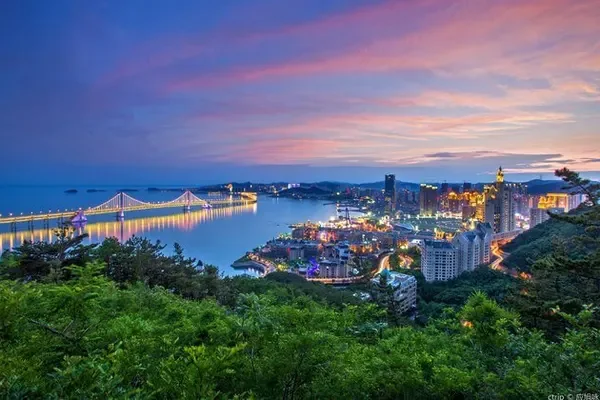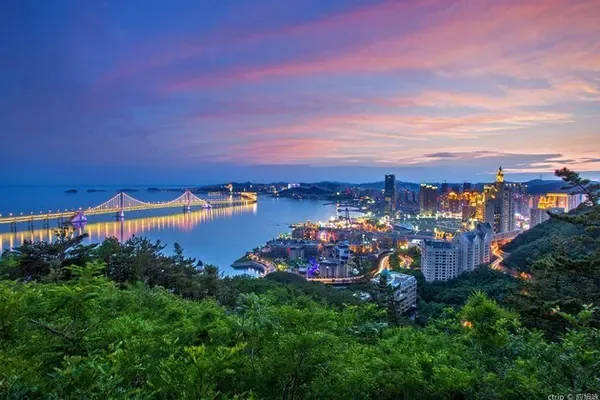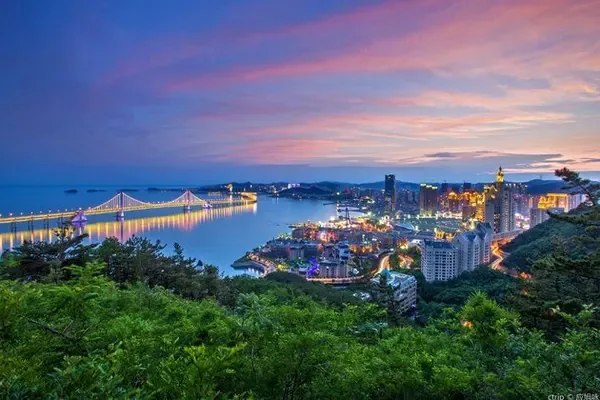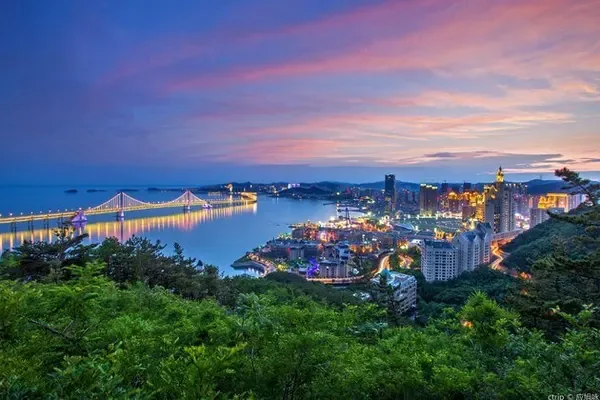Kunlun Mountain in Qinghai has always been sacred in the hearts of reporters. Coincidentally, in September 2008, the reporter had the honor to take a trip to Kunlun Mountain along the Qinghai-Tibet line to participate in the first World Intellectual Games collecting holy water from Kunlun Spring. Drive from Golmud, go south out of the urban area and go west not far to the Qinghai-Tibet Line, where the railway and highway run parallel. The Qinghai-Tibet Highway is National Highway 109, and the newly built railway is known as the "Heavenly Road".

On September 3, 2008, after coming out of Golmud, on both sides of the road was the endless black Gobi Desert with dots of bushes. This is the southeast edge of the Qaidam Basin. 32 kilometers ahead is Nanshankou Station, which is Qinghai-Tibet The starting point of the first phase of the railway project, on June 29, 2001, the news of the construction of the Qinghai-Tibet Railway was spread from here, spreading throughout Qinghai-Tibet, China, and the world.

Not far from the Nanshankou toll station, two monuments stand on both sides of the Qinghai-Tibet Highway, and the spectacular monuments will hit people's eyes. On the east side of the stele is engraved "the ancestor of Wanshan", and on the west side is "Majestic Kunlun".
The eight big red characters glistened under the sunlight, making them extremely eye-catching. Xiao Yan, the driver of the accompanying Golmud Tourism Bureau, told the reporter: "This sign means that we have entered Kunlun Mountain from here.

Continue to drive and enter the Golmud River Valley area, cross the river several times, and in front of you, you will see the Kunlun Bridge. Here, the Kunlun River (upstream of the Golmud River), which originated at the northern foot of the Kunlun Mountains, has long-term denuded rock formations, and has penetrated into a 30-meter-deep -40 meters canyon, the bottom of the canyon is wide and tortuous, and the narrowest part of the valley is only one step away. In the middle, the melting water of snow mountains rushes in and roars away, and the sound of water is deafening.

Kunlun Mountain is like a giant python, and it is known as "Mang Kunlun". According to historical records, Kunlun Mountain is the place where the jade dragon soars into the sky, and is known as the spine of Asia. The Kunlun Mountains start from the Pamirs in the west. The mountains are 2,500 kilometers long, with an average altitude of 5,500-6,000 meters and a width of 130-200 kilometers. The total area is more than 500,000 square kilometers. It is the new green peak - Bugdaban Peak, with an altitude of 6860 meters, which is the highest point in Qinghai Province.

Kunlun Mountain has undulating peaks, deep and ancient forests, and beautiful scenery. At the turn of spring and summer, the mountains are full of green trees and flowers, making Kunlun Mountain more charming. It is one of the famous scenic spots in Qinghai Province. Cui Hong, a historian of the Northern Wei Dynasty, called it "the ancestor of the mountains on the sea" and "most of the world's famous mountain monks" in "The Spring and Autumn Period of Sixteen Kingdoms".

Since ancient times, Kunlun Mountain has attracted Taoists from the Buddhist world to build temples and temples here, cultivate one's character and self-cultivation, and preach scriptures. As far back as the Han and Tang dynasties, there were many temples and incense here. In the Jin and Yuan Dynasties, Wang Chongyang, the founder of the Quanzhen School of Taoism in China, and his seven disciples chose this place as the "Cave Heaven and Paradise" for the establishment of the school, leaving many fascinating Taoist relics.

Traveling on the Qinghai-Tibet Highway, you can occasionally see camel caravans and flocks led by herdsmen migrating, which is very spectacular. And the railway always goes left and right. Especially when there is a train running, the long train runs on the rolling hills, like a billowing black dragon.

90 kilometers along the Qinghai-Tibet line, at an altitude of 3,700 meters, there is a small town called Nachitai, which is where the Kunlun Spring is located. It is an excellent natural mineral spring and is regarded as a wonder of Kunlun. The Nachi Fountain, one large and one small, are 50 meters apart. The big spring is on the side of the Qinghai-Tibet Highway. The surrounding of the spring is built with stones to form an octagonal outer circle and an inner octagon. The spring platform is 1.6 meters in diameter and 1 meter deep. There is an exit. Today, the Golmud Municipal Government has built a beautiful hexagonal pavilion with green glazed tiles and red pillars for Kunlun Spring and erected a monument to Kunlun Spring.

Kunlun Spring is very prosperous, gushing out day and night, turning up layers of small waves from time to time, and making noises. The water temperature is constant at 20°C throughout the year. The spring pool is surrounded by a polygonal pattern made of granite slabs. In the center, a clear spring suddenly gushes out of the pool, forming a crystal clear mushroom shape, throwing countless jasper-like petals around, like a blooming lotus. , It seems that broken jade fell into a pool of clear pools, and then rushed to the surging Kunlun River.

So far, there is still a legend that Princess Wencheng rested here when she entered Tibet in Nachi Fountain. According to legend, when Princess Wencheng married Tubo, she carried a huge statue of Sakyamuni Buddha with her. When the princess and her party came to Nachi Terrace at the foot of Kunlun Mountain, they were exhausted due to the high mountain and the long road. So, the princess ordered the brigade to rest on the spot. When cooking at night, they found that there was no water nearby, so everyone had to eat dry food and sleep with their clothes on.

The next morning, when people woke up, they found that the mountain where the Shakya Buddha statue was placed last night had been crushed into a platform. Not far from the platform, a crystal spring gushed out and gurgled. People suddenly understood that it was Sakyamuni Buddha who pressed out the spring water in the mountain. In order to express her respect to the Buddha, the pious princess threw a string of pearls on her body into the spring, and the spring water became cooler and sweeter. Therefore, people call Nachi Terrace "Buddha Terrace" and Kunlun Spring "Pearl Spring".

There is also a legend that the Creator Fanmo went to the Queen Mother of the West's birthday banquet on the Kunlun Mountains, and on his way back, he drank the nectar presented by the Queen Mother of the West without hesitation. The lotus shrine it rides on turns into Chitai Mountains, and the overflowing nectar turns into Kunlun Spring.
On September 4, 2008, at the launch ceremony of the "Wisdom Traceability" holy water collection of the first World Smart Games, next to the "Kunlun Spring", three girls from the Tibetan, Han, and Mongolian ethnic groups collected the holy water as saintess messengers; two saints The female hand holds the water from the Kunlun Spring into a holy water bottle made of Kunlun Mountain stone held by a saint, and they hold the holy water bottle high together.

Kunlun Shenquan is the largest ice-free spring in Kunlun Mountains. The spring water seeps into the ground after the melting of ice and snow in Kunlun Mountains. "Iceberg Nectar". The spring water is low salinity bicarbonate chloride, calcium and magnesium mineral water. Before it spouts out of the stratum, it has stored underground for more than 20 years, dissolving strontium, calcium, potassium, bicarbonate and other chemical elements that are beneficial to human health from the surrounding environment. Among them, the content of strontium is as high as 0.7 mg/L, which has a good curative effect on the treatment of hypertension, heart disease, arteriosclerosis and other diseases. It is a high-quality, natural drinking mineral water. It is a necessary place for the car adventure line on the roof of the world, and one of the important scenic spots in the Taoist holy land of Kunlun Mountains.

Going west along the Qinghai-Tibet line for dozens of kilometers, the continuous towering snow-capped mountains will appear on the side of the road. This is called Xidatan, and it is also the location of the famous Jade Everest in Kunlun Mountains. Yuzhu Peak, also known as Keke Saijimen Peak, is 6,178 meters above sea level and is located in the eastern section of the Kunlun Mountains, at 94.2 degrees east longitude and 35.6 degrees north latitude. Yuzhufeng is covered with snow all the year round, with vertical and horizontal glaciers, majestic and majestic. There are more than 20 snow peaks above 5,400 meters above sea level around the main peak.

Continue westward through Xidatan, and arrive at the Kunlun Mountain Pass at 165 kilometers of the Qinghai-Tibet line. On the side of the road, you can see the "Kunlun Mountain" sign with an altitude of 4,767 meters in both Tibetan and Chinese. Kunlun Mountain Pass is located in the southwestern part of Qinghai, in the middle of Kunlun Mountains. It is the only place where Qinghai and Gansu provinces lead to Tibet. It is also a major pass on the Qinghai-Tibet Highway.

Standing at the Kunlun Mountain Pass, you can have a panoramic view of East and West Kunlun. Looking to the east, in the quiet eternal snow field, Yuxu Peak stands alone and majestic, overwhelming the mountains, creating a unique natural landscape in the world of ice and snow.
Legend has it that Yuxu Peak is the incarnation of Princess Yuxu, the daughter of the Queen Mother of the West. Looking from a distance, a black dragon galloping on the sky road under the blue sky and white clouds is very spectacular.

On the green grass at the foot of the mountain, the temples and palaces are well arranged, forming a beautiful picture of a fairyland on earth. Not far away is Yuzhu Peak, which is said to be the incarnation of Princess Yuzhu, another daughter of the Queen Mother of the West. Yuzhufeng is covered with snow all the year round, glaciers are vertical and horizontal, majestic and majestic. The ice and snow terrain on the south side of Yuzhufeng is different, and the end of the glacier forms a ice piano more than 10 meters high. The alpine meadow belt on the south side of Mount Yuzhu is a paradise for wild animals, and there are often groups of rare animals such as Tibetan antelopes and Tibetan wild donkeys.

There are many monuments at the Kunlun Mountain Pass. The Kunlun Mountain Pass marker stele with colorful prayer flags flying around is divided into five parts: the main monument, the auxiliary monument, the companion monument, the sculpture, and the chassis. The material is white marble. The main stele is 4.767 meters high, which is one-thousandth of the altitude of the Kunlun Mountain Pass. The base of the stele is made of granite blocks to form a 9.6-square-meter foundation, which symbolizes that she stands on the solid land of 9.6 million square kilometers in the motherland.
Every year, descendants of Chinese people from all over the world come here to search for their ancestors. They worship on the hillside devoutly.

The other is the Sonam Dajie Monument, which is covered with pure white hada. Sonam Dajie, a hero who sacrificed his life to protect the Tibetan antelope and Hoh Xil, his loyal soul is attached to Kunlun. The eyes of the hero are still Watching ahead vigilantly - Hoh Xil, which he defended with blood and life. Not far from here, there are "Kunlun Mountain Pass Monument", "Kunlun Mountain Pass West 8.1 Earthquake Monument" and "National Geological Park Monument".

On November 14, 2001, a strong earthquake of magnitude 8.1 occurred in the west of the Kunlun Mountain Pass. It was the largest earthquake in China in the past 50 years, and it was also the largest earthquake since the beginning of the 21st century. The surface rupture and other phenomena formed by this earthquake are the only earthquake relics in China, rare in the world, the most complete, the most spectacular and the latest earthquake relics, and they are precious natural heritages of mankind. Earthquake relics have been recognized by the international geological community as a natural "classroom" for studying the Earth's Himalayan orogeny and the mechanism of strong earthquakes.

The monument was funded by the China Earthquake Administration and has practical significance for the protection and research of earthquake relics and the popularization of earthquake knowledge. It is understood that due to the proximity to the highway, since the earthquake, the earthquake rupture zone near the Kunlun Mountain Pass has attracted a large number of passing drivers and tourists every day with its magical and spectacular sights. Traveling through Kunlun on the Qinghai-Tibet Line, although it was a quick ride to and fro, it left behind indelible memories... (Photo: Feng Ganyong)



